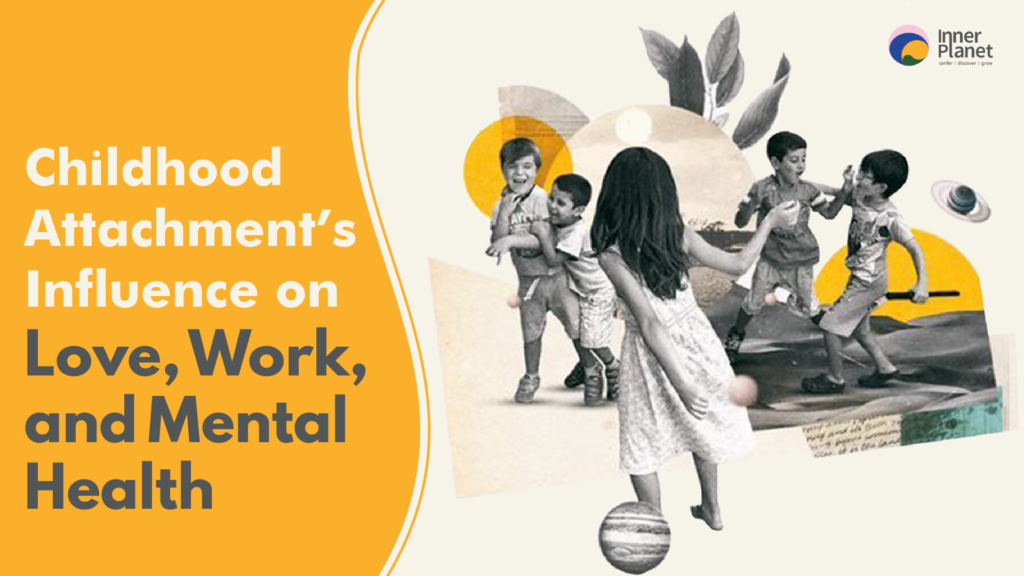From the moment we are born, our interactions with our primary caregivers shape how we navigate relationships, emotions, and challenges throughout the rest of our life.
Attachment theory, developed by John Bowlby and expanded by Mary Ainsworth, explains how early caregiving experiences create mental blueprints that influence our behavior in adulthood. These blueprints shape how we trust others, regulate emotions, and handle intimacy.
The four primary attachment styles—Secure, Anxious, Avoidant, and Disorganized—impact our romantic relationships, mental health, and even career paths. Let’s explore how these attachment styles shape various aspects of adult life and whether they can change over time.
Understanding Attachment Theory
Attachment theory suggests that infants (and humanity in general) are wired to seek comfort and safety from our caregivers, and these early experiences shape how we connect with others throughout life. As adults, whether we view relationships as safe and supportive or unpredictable and distressing is largely influenced by these formative interactions.
- Internal Working Models: As children, we develop mental blueprints based on our caregivers’ responses. When care is consistent and nurturing, we learn that people are reliable and relationships are secure. Conversely, inconsistent or neglectful care may lead us to expect rejection or abandonment, shaping how we approach relationships later in life.
- The Secure Base: When children feel supported by their caregivers, they develop confidence to explore their environment and take healthy risks. This sense of security extends into adulthood, fostering emotional resilience and the ability to form meaningful relationships.
- Lifelong Influence: Attachment patterns influence how we trust, communicate, and regulate emotions in close relationships, but they can also shift based on life experiences and personal development.
The Four Childhood Attachment Styles & Their Adult Manifestations
It is important to remember attachment styles are not rigid categories that define every relationship in our lives. A person may exhibit different attachment tendencies depending on the relationship—secure in friendships but anxious in romantic relationships, for example. Furthermore, attachment styles are not permanent; life experiences, mental health care (like therapy), and personal growth can influence how we relate to others over time. Understanding these styles is not about labeling ourselves but rather about recognizing patterns that shape our interactions and learning how they might evolve.
With this in mind, let’s explore the four primary attachment styles, how they develop in childhood, and the ways they continue to influence our thoughts, emotions, and behaviors into adulthood.
1. Secure Attachment
- Childhood: Secure attachment develops when caregivers are consistently responsive, emotionally available, and attuned to a child’s needs. These children learn to trust that their needs will be met, fostering a sense of safety and confidence in relationships.
- Adulthood: Secure individuals maintain healthy relationships, manage emotions well, and display resilience in challenges. They tend to have higher relationship satisfaction, better communication skills, and stronger coping mechanisms in stressful situations.
2. Anxious Attachment
- Childhood: Anxious attachment typically arises when caregiving is inconsistent—sometimes attentive and nurturing, other times distant or unavailable. This unpredictability leads children to become hyper-aware of their caregiver’s presence and approval, fostering anxiety around abandonment.
- Adulthood: Anxious individuals often crave closeness but worry about being rejected. They may seek constant reassurance from partners and overanalyze interactions. They are more prone to anxiety and depressive symptoms due to their heightened sensitivity to relationship dynamics.
3. Avoidant Attachment
- Childhood: Avoidant attachment emerges when caregivers are emotionally distant, dismissive, or overly focused on independence. These children learn that expressing needs does not result in comfort or support, leading them to suppress their emotions and become self-reliant.
- Adulthood: Avoidant individuals struggle with intimacy, prioritize independence, and often suppress emotions. They may seem self-sufficient but have difficulty relying on others, sometimes leading to emotional isolation. They often struggle to express emotions, which can contribute to long-term psychological strain.
4. Disorganized Attachment
- Childhood: Disorganized attachment often develops in environments where caregivers are a source of both comfort and fear—such as in cases of psychological trauma, abuse, neglect, or erratic caregiving. Children with this attachment style experience confusion and distress, unsure of how to seek safety.
- Adulthood: These individuals may exhibit contradictory behaviors, struggle with trust, and experience emotional instability. They may crave closeness but simultaneously push others away due to deep-seated fears of being hurt.
The Impact of Attachment Style on Romantic Relationships
Attachment styles strongly influence how we behave in romantic relationships:
- Secure Attachment: Leads to healthy boundaries, effective communication, and trust.
- Anxious Attachment: Can result in fear of abandonment, need for reassurance, and emotional highs and lows. This can lead to intense but often turbulent relationships.
- Avoidant Attachment: Often causes difficulty with emotional intimacy and reluctance to rely on a partner. This can lead to withdrawing when a partner seeks emotional support.
- Disorganized Attachment: Associated with unpredictable behaviors, trust issues, and relational instability.
Mental Health Implications
- Emotional Regulation: Secure individuals tend to experience a balanced emotional life, where they can acknowledge and express their emotions in a healthy way. In contrast, insecure attachment styles often lead to difficulty managing stress and heightened emotional reactivity. Anxiously attached individuals may feel overwhelmed by emotions and struggle to self-soothe, while avoidant individuals tend to suppress or detach from their emotions, leading to long-term psychological strain.
- Stress Response: Attachment style plays a crucial role in how individuals respond to stress. Anxiously attached individuals often exhibit an overactive stress response, leading to symptoms such as increased heart rate, excessive worry, and difficulty calming down. In contrast, avoidantly attached individuals suppress their stress responses, which may seem like resilience but can actually contribute to long-term health issues like hypertension and immune system dysfunction.
- Links to Disorders: Insecure attachment can contribute to emotional distress and difficulty managing mental health. Anxious attachment is often linked to increased vulnerability to anxiety and depressive symptoms, while avoidant attachment can lead to emotional suppression and difficulty seeking help. Disorganized attachment, due to its association with early trauma, may contribute to emotional instability and challenges in self-regulation. While these patterns can present obstacles, they do not define an individual’s mental health outcomes, and support systems, therapy, and personal development can help mitigate these effects.
Career and Workplace Behaviors
- Workplace Relationships: Secure individuals are often more comfortable in collaborative settings, while avoidant individuals may prefer working independently.
- Career Exploration: Secure attachment is associated with greater confidence in job searches and career shifts, while anxious individuals may be more sensitive to feedback from supervisors.
- Leadership Styles: Secure leaders foster positive work environments, while avoidant leaders may struggle with emotional intelligence. Anxiously attached leaders may micromanage due to fear of failure.
Our attachment styles, rooted in early childhood experiences, shape our relationships, mental health, and professional life. While these patterns can feel deeply ingrained, they do not define us permanently. With self-awareness, therapy, and positive relationships, people can reshape the way they connect with others. Many people, even those with insecure attachment styles, learn to form secure bonds over time, finding stability and emotional growth through supportive environments and conscious effort. Understanding our attachment tendencies is not about limitation—it is the first step toward creating deeper, healthier, and more fulfilling connections in all aspects of our life.
If you want to understand your attachment style and how it’s impacting you, we’re just a call away!
References
- Bowlby, J. (1969/1982). Attachment and loss, Vol. 1: Attachment. Basic Books.
- Cassidy, J., & Shaver, P. R. (Eds.). (2008). Handbook of attachment: Theory, research, and clinical applications (2nd ed.). Guilford Press.
- Fraley, R. C. (2018). A brief overview of adult attachment theory and research. Retrieved from https://labs.psychology.illinois.edu/~rcfraley/attachment.htm
- Gillath, O., Casebier, J., Canterberry, M., & Karantzas, G. (2018). Birth status and adult attachment. Journal of Social and Personal Relationships, 36(8), 2345–2375. https://doi.org/10.1177/0265407518787357
- Hazan, C., & Shaver, P. R. (1987). Romantic love conceptualized as an attachment process. Journal of Personality and Social Psychology, 52(3), 511–524.
- Mikulincer, M., & Shaver, P. R. (2012). An attachment perspective on psychopathology. World Psychiatry, 11(1), 11–15. https://doi.org/10.1016/j.wpsyc.2012.01.003
- Mikulincer, M., & Shaver, P. R. (2016). Attachment in adulthood: Structure, dynamics, and change (2nd ed.). Guilford Press.
- Mikulincer, M., & Shaver, P. R. (2019). Attachment orientations and emotion regulation. Current Opinion in Psychology, 25, 6–10. https://doi.org/10.1016/j.copsyc.2018.02.006
- Rajkumar, R. P. (2022). Comorbid depression and anxiety: Integration of insights from attachment theory and cognitive neuroscience, and their implications for research and treatment. Frontiers in Behavioral Neuroscience, 16. https://doi.org/10.3389/fnbeh.2022.1104928
- Rees, C. (2007). Childhood attachment. British Journal of General Practice, 57(544), 920–922. https://doi.org/10.3399/096016407782317955
- Simpson, J. A., & Rholes, W. S. (2017). Adult attachment, stress, and romantic relationships. Current Opinion in Psychology, 13, 19–24. https://doi.org/10.1016/j.copsyc.2016.04.006
- Wise, R. M., Alsan, B., & Taleb, E. (2022). Career satisfaction and adult attachment style among working adults: Evidence from Turkey. Trends in Psychology, 30(4), 763–787. https://doi.org/10.1007/s43076-022-00152-z


